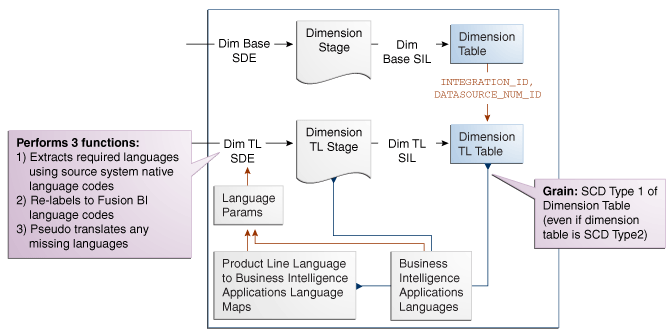About Dimension Translation Tables
Domains are dimensional attributes that have a relatively small number of distinct members, have a low cardinality relative to the number of records in the dimension, and are often used in aggregations. Dimensions have other attributes that require translation that may not fit one or more of these criteria. Dimensions may have translatable attributes that have a high cardinality relative to the dimension or may have a large number of members, and, thus, are not likely candidates for aggregation.
If the domains ETL process was implemented in such cases, performance would be very poor. As a result, these particular attributes are implemented using dimension translation tables.
Data Model
If a dimension has such high-cardinality attributes that cannot be treated as domains, the dimension will have an extension table that follows the _TL naming convention. If the _TL table has a one-to-one relationship with the dimension table (after filtering for languages), the _TL table name will match the dimension table name. For example, W_JOB_D_TL is the translation table associated with the W_JOB_D dimension table. If the _TL table does not have a one-to-one relationship with any dimension table, its name will reflect content.
The dimension and dimension translation table are joined on the translation table's INTEGRATION_ID + DATASOURCE_NUM_ID. If the translation and dimension tables have a one-to-one relationship (after filtering for language), the join to the dimension table is on its INTEGRATION_ID + DATASOURCE_NUM_ID. Otherwise, there will be a %_ID column in the dimension table that is used to join to the translation table.
ETL Process
Similar to the Oracle BI Applications domain ETL process, when using dimension translation tables, ETL tasks extract the translated values from the transactional system. Rather than the domain staging table being loaded, the dimension's translation staging table is loaded. The ETL process then moves these records into the dimension translation table.
Only those translation records that match one of the languages that have been installed in the data warehouse are extracted from the transactional system. If translated records are not found in the transactional system matching a data warehouse Installed language, the ETL will generate a 'pseudo-translated' record for that language by copying the record that corresponds to the data warehouse Base language.
Some source applications store translations that can be extracted and loaded into the translation table. Some source applications do not maintain translations for an entity that corresponds to a dimension table. In these cases, whatever record is available is extracted and used as the Base language record, which is then used to generate pseudo-translations for all other Installed languages.
Oracle BI Applications does not support Type 2 SCD tracking of dimension translation attributes when the dimension and translation tables have a one-to-one relationship with each other. These tables are joined on INTEGRATION_ID + DATASOURCE_NUM_ID, and, therefore, can be joined to a single record in the translation table. Attributes in the dimension table can be Type 2-enabled, but the current and prior records will always have the same translated value. This figure describes the ETL domain process.
Oracle BI Enterprise Edition
In Oracle BI EE, joins are created between the dimension and translation tables as normal. The translation table is brought in as another supporting table in the logical table source. If a user selects an attribute from the translation table, it will be included as a joined table in the SQL that Oracle BI EE generates. If the user does not select a translation attribute, the translation table will not be included in the generated SQL.
To ensure this behavior, the physical join between the dimension and translation tables is configured as one-to-many with the dimension table on the many side.
An important consideration is filtering on a user's language. If the language filter is included in the logical table source as a content filter, the translation table will always be joined whether a user selects a translation attribute or not. To avoid this behavior, opaque views are created in the physical layer that include a WHERE clause on the user's session language. Filtering on the user's language is still possible, but as the filter criteria is not implemented as a logical table source content filter, it is ensured that the translation table is only joined when necessary.
Localizing New Domain Members and Oracle BI Repository Metadata
If you added new domain members that require localization or want to add string localizations in the Oracle BI Repository metadata, see About Setting Up Domain Member Mappings, in Oracle Business Intelligence Applications Configuration Guide.
